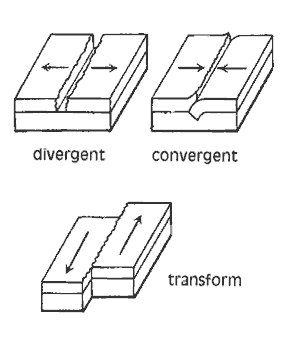BACKGROUND:
According to the theory of plate tectonics, the
Earth's crust and upper mantle are broken into moving plates of
"lithosphere." The lithospheric plates are solid rock. There are
several very large plates, each consisting of both oceanic and continental
portions. There are a dozen or more smaller plates. The plates average about
80 kilometers (50 miles) in thickness.
All of the plates are moving. They are slow, moving at
speeds of centimeters to tens of centimeters per year. They slide along on
top of an underlying mantle layer called the asthenosphere, which contains a
little magma (molten rock). The plates have been moving for millions and
millions of years.
As they move, plates interact at their edges or
boundaries. There are three basic directions or types of boundary
interactions. In some places, two plates move apart from each other; this is
called a diverging plate boundary. Elsewhere two plates move together; this
is a converging plate boundary. Finally plates can also slide past each
other horizontally. This is called a transform plate boundary.
The movement of the plates generates stress at plate
boundaries. The type of stress is different at each type of plate boundary.
At converging plate boundaries rocks are squeezed, at diverging plate
boundaries they are stretched, and at transform boundaries they are pushed
past each other. Because the plates are rigid rock, they resist this motion
until they break, creating earthquakes.
PROCEDURE:
In this activity you will introduce the terms of
movement of the outer portion of the Earth and explain that these movements
cause stress at plate boundaries.
- Explain to the class that the Earth's outermost
layer is made of rock, and is called the crust. Make sure that the
students understand that continental crust or land is mostly above
water, and oceanic crust is land that is below
 water. Illustrate these
areas on an inflatable globe. Explain that the crust is the top part of
the plates.
water. Illustrate these
areas on an inflatable globe. Explain that the crust is the top part of
the plates.
- Explain to the students that the plates are moving.
Explain the three types of motion between plates. Introduce the words
converge, diverge, and transform (slip/slide) to the class. Have the
students repeat the words several times while you demonstrate the
motions with your hands. Explain that stress is generated where the
plates touch and move past each other, at their boundaries.
- Have
the students illustrate these words with a motor activity. Tell them
that they will be able to demonstrate plate movement in other ways
during lab.
Have the students stand shoulder to shoulder in two lines facing each
other. Have the lines move toward each other. Explain that this is like
when two plates move toward each other (this illustrates a CONVERGING
plate boundary). Have the lines move away from each other (this
illustrates a DIVERGING plate boundary). Have the students in one line
take one step to the right while the students in the second line take
one step to the left (this illustrates a TRANSFORM plate boundary).